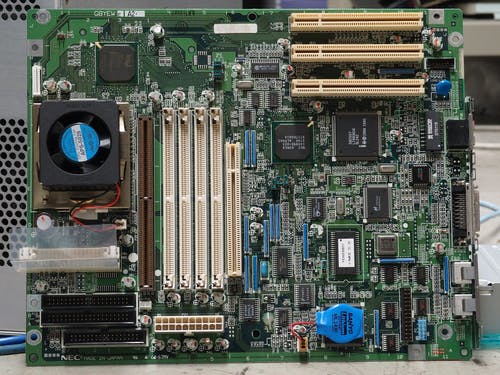
What is a motherboard?
A motherboard, also known as MB, mainboard, system board, main circuit board, or system board, is one of the most essential parts of a computer system. It holds together many of the computer's crucial components, including the central processing unit (CPU), memory, and connectors for input and output devices. A motherboard allows all the parts of your computer to receive power and communicate with one another.
A motherboard allocates power and allows communication to and between the CPU, RAM, and all other computer hardware components. The motherboard's main job is to hold the computer's microprocessor chip and let everything else connect to it. Everything that runs the computer or enhances its performance is either part of the motherboard or plugs into it via a slot or port.
What are the functions of a motherboard?
- The motherboard acts as the central backbone of
a computer on which other modular parts are installed such as the CPU, RAM, and
hard disks.
- The motherboard also acts as the platform on which various expansion slots are available to install other devices.
- The motherboard is responsible to distribute power to the various components of the computer.
- They are also used in the coordination of the various devices in the computer and maintain an interface among them.
- Some of the Sizes in which the motherboards are available are BTX, ATX, mini-ATX, micro-ATX, LPX, NLX, etc...
The Difference between a motherboard and a CPU
Most people mistake the motherboard for the CPU (Central Processing Unit). The difference is that: While the motherboard is a large, flat piece of silicon, while the CPU (Central Processing Unit) is a chip installed on the motherboard.
How does a motherboard work?
Since the motherboard works in unison to make a computer function, how then does it work? Just like there are different branches of the body, a motherboard has different parts within it that work together to transmit data to each other.
The layout of a motherboard is called the form factor. The form factor affects where individual components go and the shape of the computer's case. There are several specific form factors that most PC motherboards use so that they can all fit in standard cases. While all motherboards operate the same way, different models have different kinds of ports, dimensions, and mounting holes. Popular form factors include:
- ATX: Short for Advanced Technology eXtended, ATX is a specification used to outline motherboard configuration and dimensions to improve standardization.
- microATX: The microATX is a motherboard
that is 9.6" wide x 9.6" deep and capable of being as small as
6.75" wide x 6.75" deep. This motherboard is a smaller motherboard that is used in an ATX or smaller computer case.
- Mini-ATX: Smaller than the micro version, these are
designed for mobile CPUs
- Mini-ITX: Smaller than an ATX board (6.7 x 6.7 inches),
the mini-ITX form factors are quiet and don’t use a lot of power
- Nano-ITX: In between a Pico and Mini-ITX, this works
well with thin devices
- Pico-ITX: Really tiny with a 3.9 x 2.8 in. dimension size and holds up to 1 GB Other discontinued form factors include BTX, LPX, and NLX.
Chipset: A chipset is a set of electronic components on an integrated circuit that manages the transfer of data between the CPU, RAM, storage, and I/O devices. The chipset allows data to flow between various components, namely the CPU, peripherals, ATA drives, graphics, and memory.
- Northbridge: Located on the “north†side of a chipset, it “bridges†together with the following components: CPU, RAM, and PCIe
- Southbridge: Located on the “south†side of a chipset, it “bridges†together with the following components: BIOS, USB, SATA, and PCI
Slots: Slots are just like different departments of the human body in a motherboard. They consist of:
- Memory/DIMM Slots: Used for holding RAM
- PCI: Connects expansion cards like video, network, and
sound cards
- PCIe: A modern version of PCI that can work with almost
any kind of expansion card
- USB: Used for USB connectors like flash drives
- SATA: Used for optical/hard disk/solid-state drives
This is basically a habitat for the CPU. A CPU
is a small square with a bunch of pins and connectors underneath it that help
to interpret and transmit data carried out by the northbridge part of a
chipset.
 Share
Share